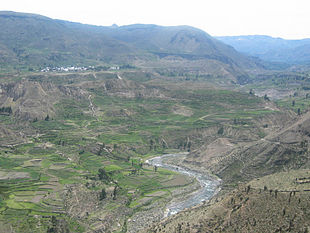Quechua (altitude level)
The Quechua (from Quechua Qhichwa "mountain valley") is an altitude level of the Andes from about 2300 to 3500 m above sea level (after Javier Pulgar Vidal ).
The Quechua region was the most densely populated high altitude region of the Andes in the Inca Empire . The Quechua language got its name after its inhabitants.
The climate is semi-arid with rainfall in summer that increases with altitude while temperatures decrease at the same time. The landscape relief is rugged and characterized by narrow valleys. The rivers and streams are rapid and carry more water in summer. Low vegetation dominates, but trees also thrive, especially along the rivers.
In the last few decades, targeted and untargeted afforestation with Eucalyptus globulus has taken place; this invasive species , originally from Australia, is now shaping the face of the landscape.
In particular, native species are maize (around a hundred different varieties), kidney beans , pumpkins , passion fruit , tomatoes , papaya , the gourd Cyclanthera pedata (kaywa) and the umbelliferous tuber Arracacia xanthorriza (raqacha) . The region's crops from Europe and Asia are wheat , peas and broad beans , plus fruit trees ( peach , sweet and sour cherries , pears , apples ).
literature
- Pulgar Vidal, Javier: Geografía del Perú - Las Ocho Regiones Naturales del Perú. Edit. Universo SA, Lima 1979.

